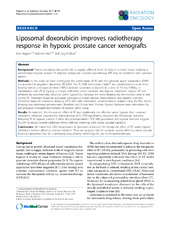| dc.contributor.author | Hagtvet, Eirik | eng |
| dc.contributor.author | Røe, Kathrine | eng |
| dc.contributor.author | Olsen, Dag R. | eng |
| dc.date.accessioned | 2012-01-20T13:57:02Z | |
| dc.date.available | 2012-01-20T13:57:02Z | |
| dc.date.issued | 2011-10-07 | eng |
| dc.Published | Radiation Oncology 2011, 6:135 | en |
| dc.identifier.issn | 1748-717X | en_US |
| dc.identifier.uri | https://hdl.handle.net/1956/5481 | |
| dc.description.abstract | Background: Tumor vasculature frequently fails to supply sufficient levels of oxygen to tumor tissue resulting in radioresistant hypoxic tumors. To improve therapeutic outcome radiotherapy (RT) may be combined with cytotoxic agents. Methods: In this study we have investigated the combination of RT with the cytotoxic agent doxorubicin (DXR) encapsulated in pegylated liposomes (PL-DXR). The PL-DXR formulation Caelyx® was administered to male mice bearing human, androgen-sensitive CWR22 prostate carcinoma xenografts in a dose of 3.5 mg DXR/kg, in combination with RT (2 Gy/day × 5 days) performed under normoxic and hypoxic conditions. Hypoxic RT was achieved by experimentally inducing tumor hypoxia by clamping the tumor-bearing leg five minutes prior to and during RT. Treatment response evaluation consisted of tumor volume measurements and dynamic contrastenhanced magnetic resonance imaging (DCE MRI) with subsequent pharmacokinetic analysis using the Brix model. Imaging was performed pre-treatment (baseline) and 8 days later. Further, hypoxic fractions were determined by pimonidazole immunohistochemistry of excised tumor tissue. Results: As expected, the therapeutic effect of RT was significantly less effective under hypoxic than normoxic conditions. However, concomitant administration of PL-DXR significantly improved the therapeutic outcome following RT in hypoxic tumors. Further, the pharmacokinetic DCE MRI parameters and hypoxic fractions suggest PL-DXR to induce growth-inhibitory effects without interfering with tumor vascular functions. Conclusions: We found that DXR encapsulated in liposomes improved the therapeutic effect of RT under hypoxic conditions without affecting vascular functions. Thus, we propose that for cytotoxic agents affecting tumor vascular functions liposomes may be a promising drug delivery technology for use in chemoradiotherapy. | en_US |
| dc.language.iso | eng | eng |
| dc.publisher | BioMed Central | en_US |
| dc.rights | Attribution CC BY | eng |
| dc.rights.uri | http://creativecommons.org/licenses/by/2.0/ | eng |
| dc.title | Liposomal doxorubicin improves radiotherapy response in hypoxic prostate cancer xenografts | en_US |
| dc.type | Peer reviewed | |
| dc.type | Journal article | |
| dc.description.version | publishedVersion | en_US |
| dc.rights.holder | Copyright 2011 Hagtvet et al; licensee BioMed Central Ltd. | en_US |
| dc.identifier.doi | https://doi.org/10.1186/1748-717x-6-135 | |
| dc.identifier.cristin | 873685 | |
| dc.subject.nsi | VDP::Medical disciplines: 700::Clinical medical disciplines: 750::Oncology: 762 | en_US |

